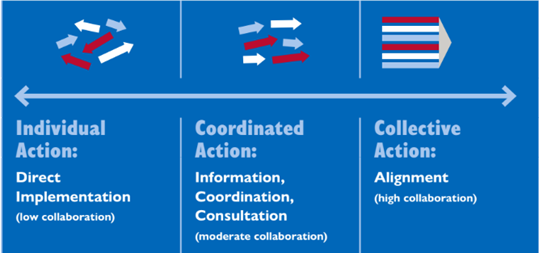How is Collective Action Related to CLA?
Collective Action is an intentional and agreed-upon process that engages interested parties to take joint actions in support of shared objectives or a shared issue, and represents one of many methods to implement USAID’s Collaborating, Learning, and Adapting (CLA) framework. New Collective Action resources, including a Guide for USAID Missions and a Guide for Facilitators, suggests the approach is a viable and effective option for supporting localization and inclusive development at both project and activity levels. This is part one of a series of two blogs that will help readers to understand the relationship between Collective Action and CLA. It points the reader to Collective Action guides and resources in the CLA Toolkit that can help them use Collective Action to implement CLA.

Collaborating
Collective Action is by definition an act of collaboration - it cannot be undertaken alone. It is not the only, or even the best way to collaborate in every context, so users should consider carefully whether this is the right model for their problem, context, and stakeholders. Module 2: Preparing for Collective Action in the Facilitators’ Guide, along with Module 2: Assessing Suitability for Your Context in the USAID Guide, contain some excellent questions, reflections, and resources on determining whether Collective Action is the best model for planning for intentional collaboration as part of your CLA effort. The CLA Toolkit contains additional resources on how to effectively identify and engage stakeholders.
Importantly, ongoing collaboration with these stakeholders (or coalition members) is a hallmark of the Collective Action model. To do so effectively and inclusively will require a clear understanding of each member’s role. Module 3 in both the Facilitator and USAID guides identifies particular responsibilities that should be fulfilled within the Collective Action model, recognizing that the roles of members may shift over time, particularly if one aim of the Collective Action effort is strengthening local capacity.
Learning
Thinking about M&E for Learning, Module 8 in the Facilitators’ Guide: MEL for Collective Action makes a strong case for considering that the outcome of Collective Action IS the coalition, at least insofar as we want to treat group cohesion as the most important indicator of success. This can be a difficult position to defend, as “group cohesion” may seem simultaneously “too squishy” and “too output-y”. However, it makes a lot of sense when we consider that Collective Action can take a bit more time to get to other measurable technical results (it may be the only outcome we can measure initially), and that objectives (and outcomes along with them) of the Collective Action effort may shift over time. But the initial and continued focus on cohesion as well as the adaptability of the effort both underpin the sustainability of the Collective Action effort -- a group that is more cohesive has greater “stickability” over time, and one that is adaptive can better weather changes over time. We tend to do what we measure, rather than measure what we do, so measuring the “squishier” aspects of Collective Action actually help us to learn and improve the working relationships and thus the effectiveness and sustainability of the coalition over time.
Adapting
In Collective Action, success is a matter of degree and can change over time. Whether a Collective Action effort is achieving significant progress, moderate progress, or little progress, learning and adaptation can always improve effectiveness.
Collective Action requires adaptive management due to the complex nature of the context and the problems for which it is employed. Adaptations to the structure of the coalition, relationships or ways of working between members, approaches to address the development problem, and even to the objectives themselves are all possible under Collective Action. If you are employing Collective Action, using frequent Pause & Reflect opportunities can help to inform decision-making and follow through on those decisions.
Please share your thoughts, any resources you find helpful and links to current or closed projects and activities, and feedback on these guides as you get to know them to [email protected] with "Collective Action Feedback" in the subject line. We would love to hear from you.



